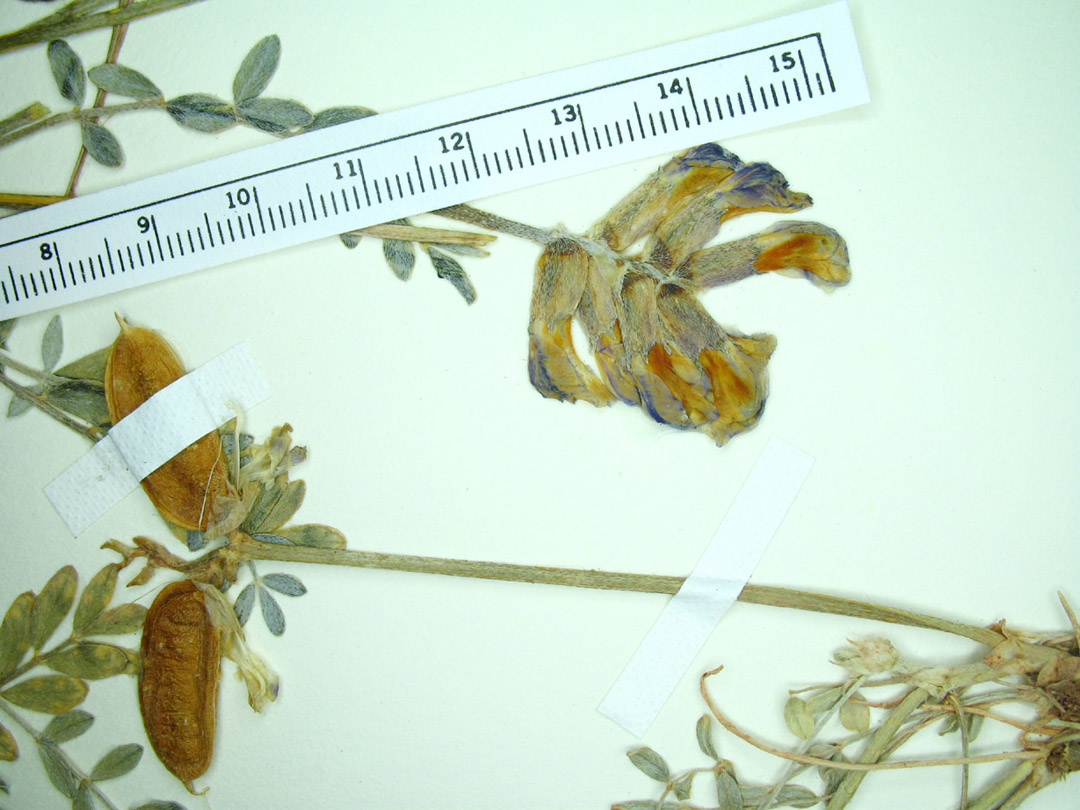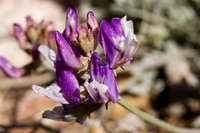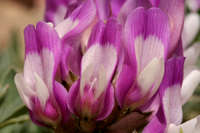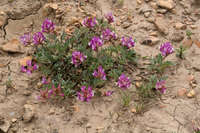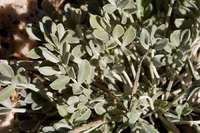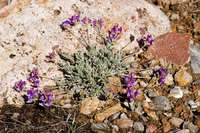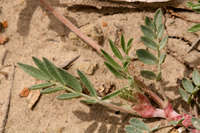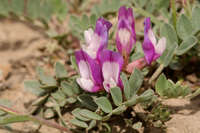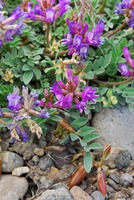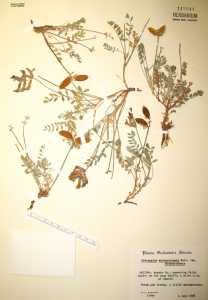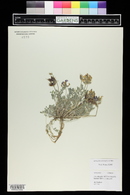|
|
|
|
Family: Fabaceae
Missouri milkvetch
[Astragalus agrestis/missouriensis, moreXylophacos missouriensis (Nutt.) Rydb.] |
Stems clustered on a stout taproot, ±prostrate, to 1(-1.5) dm, much overtopped by the lvs and peduncles; stipules free; lfls 9-17, oblanceolate or elliptic, 5-13 mm, densely canescent with malpighian hairs; peduncles 4-10 cm; racemes 2-4 cm, remaining short, with 5-15 purple fls 15-25 mm, these appearing narrower than in no. 5 [Astragalus lotiflorus Hook.]; cal-tube oblique, 6-10 mm, the subulate lobes much shorter; fr spreading, oblong, 1.5-2.5 cm נ5-9 mm, densely strigose, subterete, sessile; 2n=22. Dry hillsides, bluffs, and prairies; w. Io. and w. Minn. to s. Alta., Tex., and N.M. May, June. Ours is var. missouriensis. Gleason, Henry A. & Cronquist, Arthur J. 1991. Manual of vascular plants of northeastern United States and adjacent Canada. lxxv + 910 pp. ©The New York Botanical Garden. All rights reserved. Used by permission. Heil et al. 2013, Allred and Ivey 2012 Duration: Perennial Nativity: Native Lifeform: Forb/Herb General: Low, tufted perennial herb, up to 20 cm tall, from a taproot or underground caudex; stems short, mostly prostrate, radiating out from the center of the plant, the internodes often obscured by stipules; herbage strigose to strigulose with dolabriform hairs (hairs attached at the middle, with two pointed tips). Leaves: Alternate but often appearing basal, pinnately compound, 4-14 cm long, with 11-17 leaflets per leaf; leaflets elliptic to obovate, 3-13 mm long and 3-7 mm wide, with entire margins, pubescent on both sides; stipules distinct, 3-9 mm long. Flowers: Pink-purple or white, clustered at the ends of leafless scapes, in dense terminal racemes 1-4 cm long, with the flowers pointing upward (ascending) or outward (spreading) at maturity; flowers 1-2 cm long, with pea-flower morphology (papilionaceous), with a wide upper petal called the banner, two smaller lateral petals called wings, and a boat-shaped lower petal called the keel which contains the style and stamens. Petals pink-purple or rarely white, with the banner petal recurved about 45 degrees; sepals 5, strigulose and purple-tinged, united into a tube 6-9 mm long, topped with 5 narrow teeth, 1-4 mm long. Fruits: Pods ascending (pointing upward), oblong to oblong-elliptic, straight or slightly incurved, 1-3 cm long and 3-5 mm wide, unilocular or subunilocular, and strigulose; without a stipe (stalk at the base of the pod but above the calyx attachment point). Ecology: Found in shortgrass prairie habitats, below 8,000 ft (2438 m); flowers late March to July. Distribution: Great Plains, from Alberta, Saskatchewan, and Manitoba south through MT and ND to AZ, NM, and TX. Notes: Astragalus is an exceptionally large genus and it is wise to make a good collection with flowers and mature seed pods-- especially seed pods-- for identification. A. missouriensis is considered an acaulescent Astragalus (lacking a stem), because the stems are short and prostrate, with internodes much shorter than the length of the leaves and often obscured by the stipules. The plant often looks like a cluster of basal leaves with several leafless flower stalks emerging beyond the leaves. It is distinguished by this set of traits: leaves pinnately compound and covered with silvery, 2-branched hairs (the word for this is dolabriform or malpighian; it is hard to tell for sure without a dissecting scope); stipules distinct (not fused to each other); flowers usually pink-purple, with more than 3 per flower stalk; seed pods more than 1 cm long, mostly straight, not bladdery-inflated, unilocular (cut it in half cross-wise and there is only one chamber), and remaining attached to the plant even after splitting open and dispersing the seeds. Appears most similar to A. amphioxys, but that species has crescent-shaped seed pods that readily fall off the plant at maturity. Also similar to A. calycosus but that species has bilocular seed pods and the wing petals on the flowers are deeply cleft at the tip. It is not uncommon to find an occasional white-flowered A. missouriensis individual mixed into a normal pink-purple flowered population. Distinguish from A. tephrodes based on the shape of the seed pods (mostly straight, and round in cross-section (terete) in A. missouriensis; laterally complessed and somewhat crescent-shaped in A. tephrodes). Ethnobotany: Unknown Etymology: Astragalus comes from the Greek astragalos, ankle bone, an early name applied to some plants in this family because of the shape of the seeds; missouriensis refers to the Missouri River, as this species grows on the bluffs overlooking that river. Editor: AHazelton 2017 |
|
|
|


